Accounting Career Research Report: ACC275 - KPMG Employer Analysis
VerifiedAdded on 2022/09/18
|17
|3862
|21
Report
AI Summary
This report provides a comprehensive overview of the accounting profession, delving into various aspects such as the nature of work, work environment, required education, essential skills, and expected salaries. It examines the labor market outlook, related positions, and typical employers within the accounting industry. The report then shifts its focus to KPMG, a prominent employer in the field, analyzing its nature, size, history, organizational structure, culture, branches, subsidiaries, clients, and services. Furthermore, it explores a typical career path for accountants, including entry-level positions, qualifications, and opportunities for advancement. The report includes a reflective section, detailing the author's reasons for choosing KPMG as a subject of research, and concludes with a summary of the key findings and insights gained from the research.
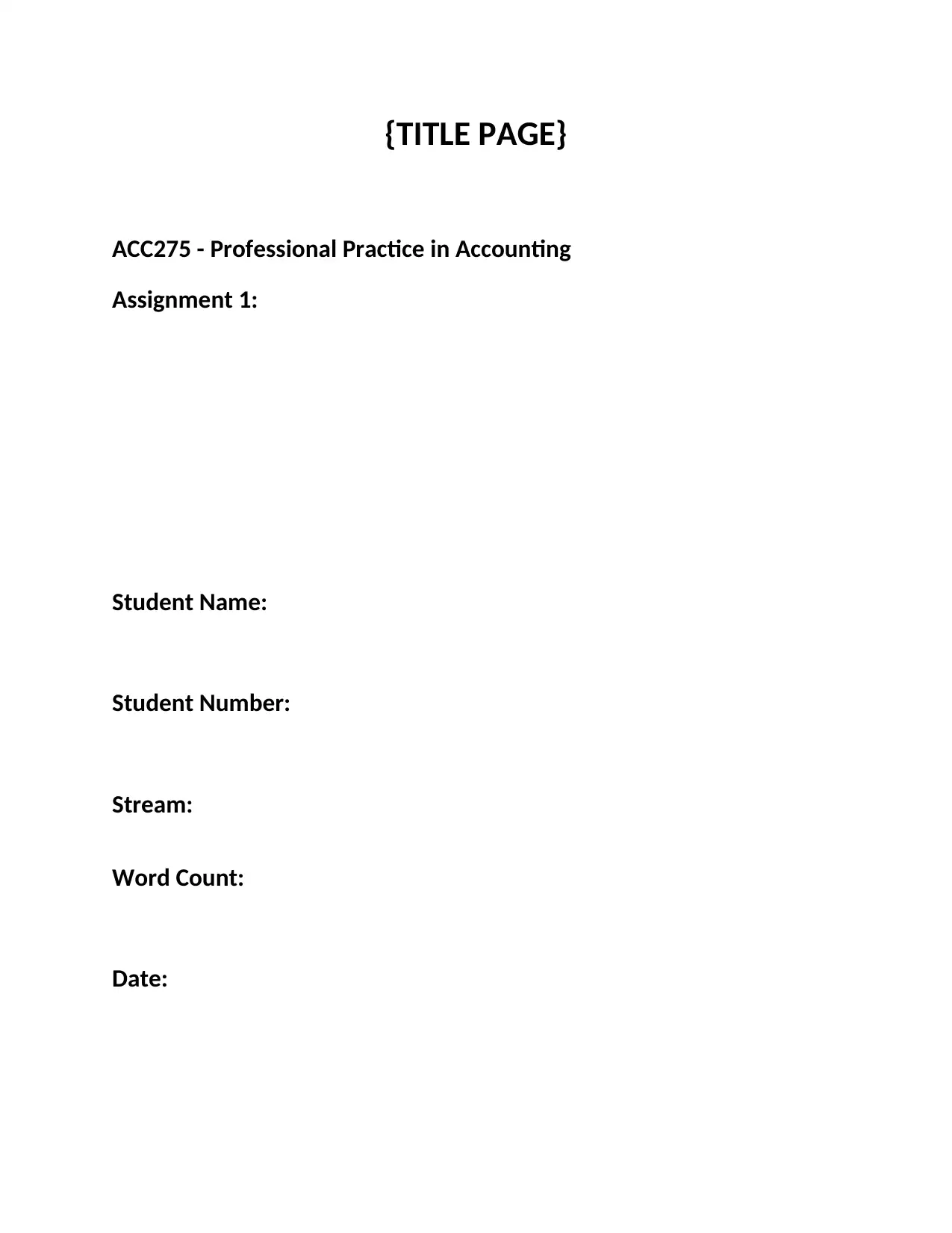
{TITLE PAGE}
ACC275 - Professional Practice in Accounting
Assignment 1:
Student Name:
Student Number:
Stream:
Word Count:
Date:
ACC275 - Professional Practice in Accounting
Assignment 1:
Student Name:
Student Number:
Stream:
Word Count:
Date:
Paraphrase This Document
Need a fresh take? Get an instant paraphrase of this document with our AI Paraphraser
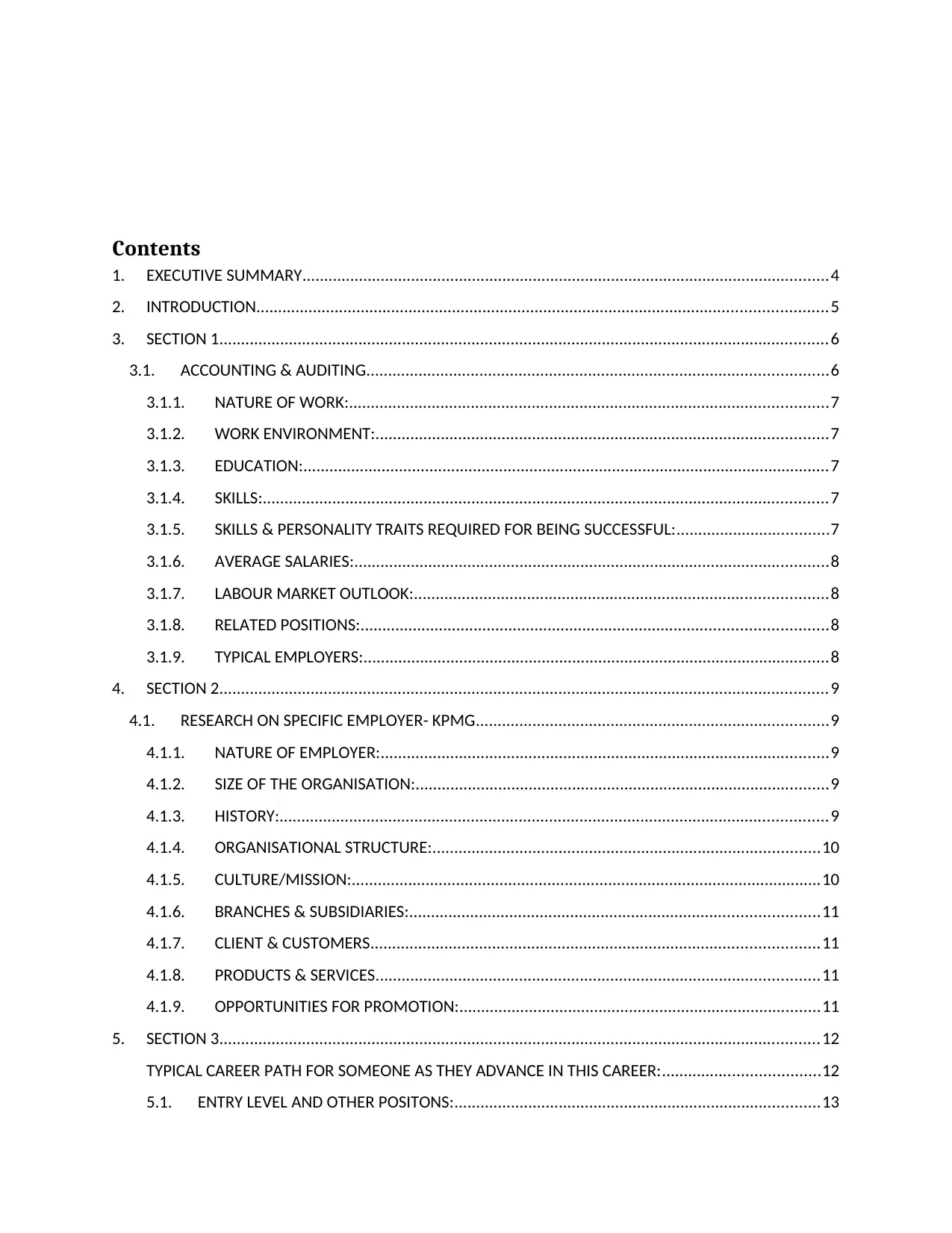
Contents
1. EXECUTIVE SUMMARY.........................................................................................................................4
2. INTRODUCTION...................................................................................................................................5
3. SECTION 1............................................................................................................................................6
3.1. ACCOUNTING & AUDITING..........................................................................................................6
3.1.1. NATURE OF WORK:..............................................................................................................7
3.1.2. WORK ENVIRONMENT:........................................................................................................7
3.1.3. EDUCATION:.........................................................................................................................7
3.1.4. SKILLS:..................................................................................................................................7
3.1.5. SKILLS & PERSONALITY TRAITS REQUIRED FOR BEING SUCCESSFUL:...................................7
3.1.6. AVERAGE SALARIES:.............................................................................................................8
3.1.7. LABOUR MARKET OUTLOOK:...............................................................................................8
3.1.8. RELATED POSITIONS:...........................................................................................................8
3.1.9. TYPICAL EMPLOYERS:...........................................................................................................8
4. SECTION 2............................................................................................................................................9
4.1. RESEARCH ON SPECIFIC EMPLOYER- KPMG.................................................................................9
4.1.1. NATURE OF EMPLOYER:.......................................................................................................9
4.1.2. SIZE OF THE ORGANISATION:...............................................................................................9
4.1.3. HISTORY:..............................................................................................................................9
4.1.4. ORGANISATIONAL STRUCTURE:.........................................................................................10
4.1.5. CULTURE/MISSION:............................................................................................................10
4.1.6. BRANCHES & SUBSIDIARIES:..............................................................................................11
4.1.7. CLIENT & CUSTOMERS.......................................................................................................11
4.1.8. PRODUCTS & SERVICES......................................................................................................11
4.1.9. OPPORTUNITIES FOR PROMOTION:...................................................................................11
5. SECTION 3..........................................................................................................................................12
TYPICAL CAREER PATH FOR SOMEONE AS THEY ADVANCE IN THIS CAREER:....................................12
5.1. ENTRY LEVEL AND OTHER POSITONS:....................................................................................13
1. EXECUTIVE SUMMARY.........................................................................................................................4
2. INTRODUCTION...................................................................................................................................5
3. SECTION 1............................................................................................................................................6
3.1. ACCOUNTING & AUDITING..........................................................................................................6
3.1.1. NATURE OF WORK:..............................................................................................................7
3.1.2. WORK ENVIRONMENT:........................................................................................................7
3.1.3. EDUCATION:.........................................................................................................................7
3.1.4. SKILLS:..................................................................................................................................7
3.1.5. SKILLS & PERSONALITY TRAITS REQUIRED FOR BEING SUCCESSFUL:...................................7
3.1.6. AVERAGE SALARIES:.............................................................................................................8
3.1.7. LABOUR MARKET OUTLOOK:...............................................................................................8
3.1.8. RELATED POSITIONS:...........................................................................................................8
3.1.9. TYPICAL EMPLOYERS:...........................................................................................................8
4. SECTION 2............................................................................................................................................9
4.1. RESEARCH ON SPECIFIC EMPLOYER- KPMG.................................................................................9
4.1.1. NATURE OF EMPLOYER:.......................................................................................................9
4.1.2. SIZE OF THE ORGANISATION:...............................................................................................9
4.1.3. HISTORY:..............................................................................................................................9
4.1.4. ORGANISATIONAL STRUCTURE:.........................................................................................10
4.1.5. CULTURE/MISSION:............................................................................................................10
4.1.6. BRANCHES & SUBSIDIARIES:..............................................................................................11
4.1.7. CLIENT & CUSTOMERS.......................................................................................................11
4.1.8. PRODUCTS & SERVICES......................................................................................................11
4.1.9. OPPORTUNITIES FOR PROMOTION:...................................................................................11
5. SECTION 3..........................................................................................................................................12
TYPICAL CAREER PATH FOR SOMEONE AS THEY ADVANCE IN THIS CAREER:....................................12
5.1. ENTRY LEVEL AND OTHER POSITONS:....................................................................................13
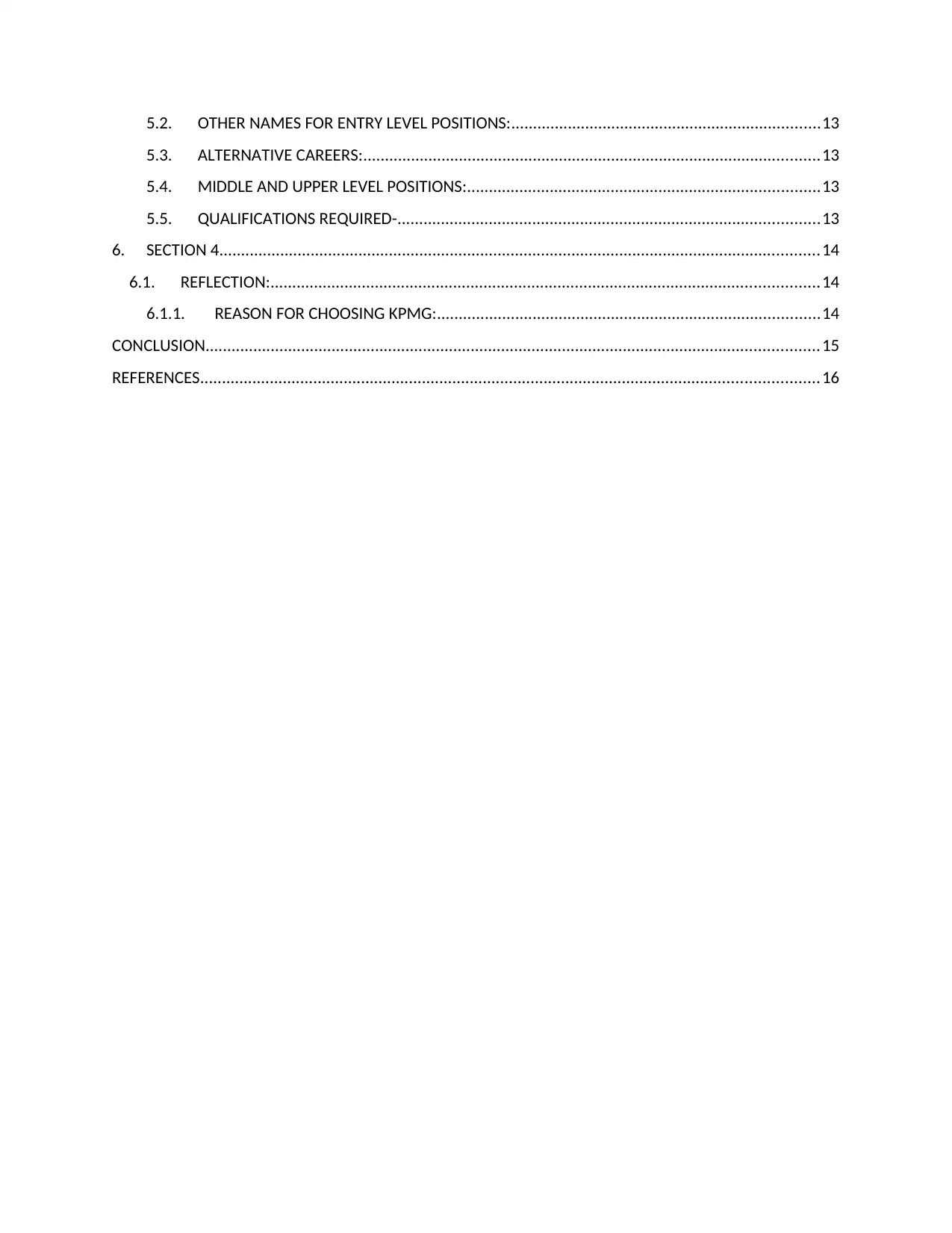
5.2. OTHER NAMES FOR ENTRY LEVEL POSITIONS:.......................................................................13
5.3. ALTERNATIVE CAREERS:.........................................................................................................13
5.4. MIDDLE AND UPPER LEVEL POSITIONS:.................................................................................13
5.5. QUALIFICATIONS REQUIRED-.................................................................................................13
6. SECTION 4..........................................................................................................................................14
6.1. REFLECTION:..............................................................................................................................14
6.1.1. REASON FOR CHOOSING KPMG:........................................................................................14
CONCLUSION.............................................................................................................................................15
REFERENCES..............................................................................................................................................16
5.3. ALTERNATIVE CAREERS:.........................................................................................................13
5.4. MIDDLE AND UPPER LEVEL POSITIONS:.................................................................................13
5.5. QUALIFICATIONS REQUIRED-.................................................................................................13
6. SECTION 4..........................................................................................................................................14
6.1. REFLECTION:..............................................................................................................................14
6.1.1. REASON FOR CHOOSING KPMG:........................................................................................14
CONCLUSION.............................................................................................................................................15
REFERENCES..............................................................................................................................................16
⊘ This is a preview!⊘
Do you want full access?
Subscribe today to unlock all pages.

Trusted by 1+ million students worldwide
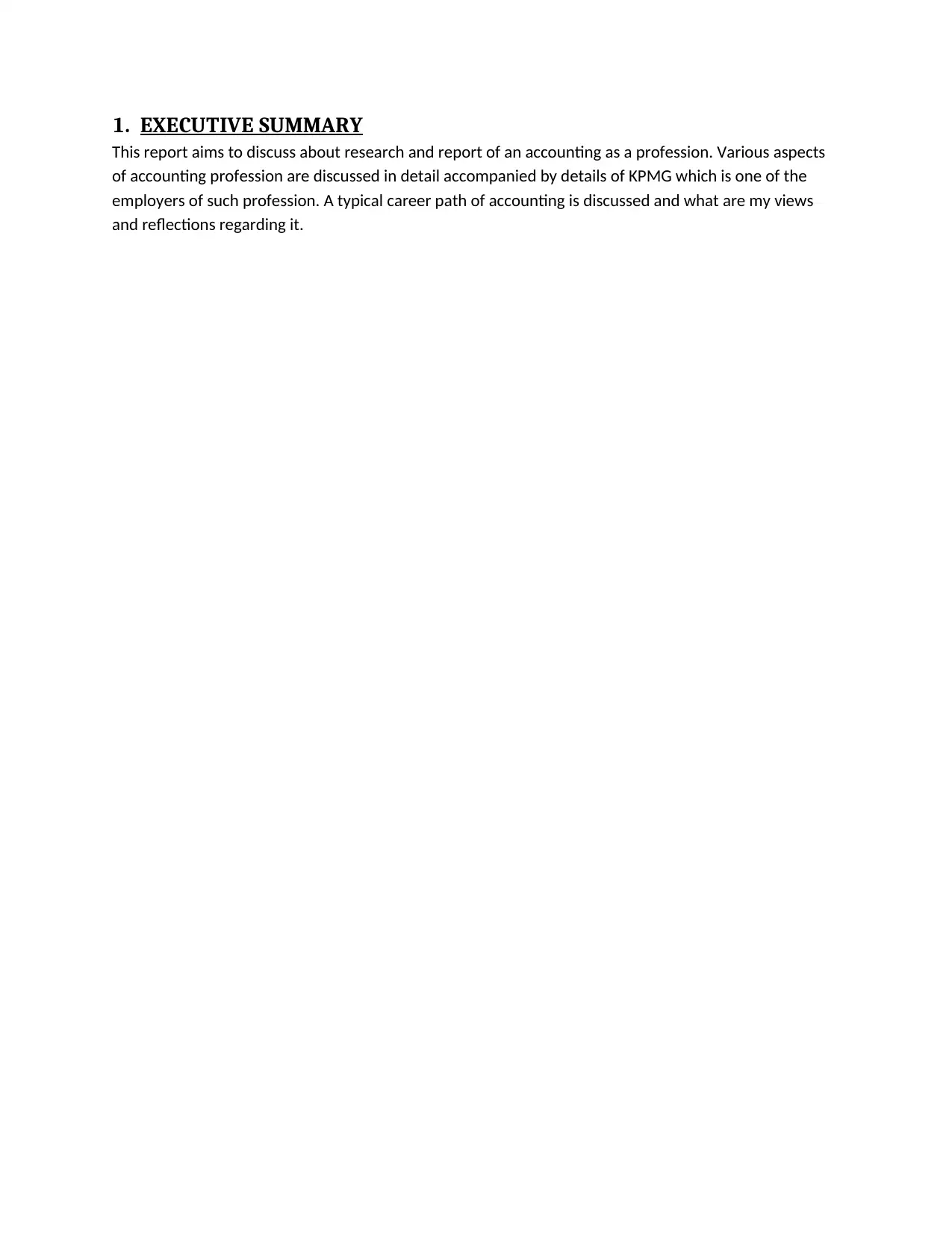
1. EXECUTIVE SUMMARY
This report aims to discuss about research and report of an accounting as a profession. Various aspects
of accounting profession are discussed in detail accompanied by details of KPMG which is one of the
employers of such profession. A typical career path of accounting is discussed and what are my views
and reflections regarding it.
This report aims to discuss about research and report of an accounting as a profession. Various aspects
of accounting profession are discussed in detail accompanied by details of KPMG which is one of the
employers of such profession. A typical career path of accounting is discussed and what are my views
and reflections regarding it.
Paraphrase This Document
Need a fresh take? Get an instant paraphrase of this document with our AI Paraphraser
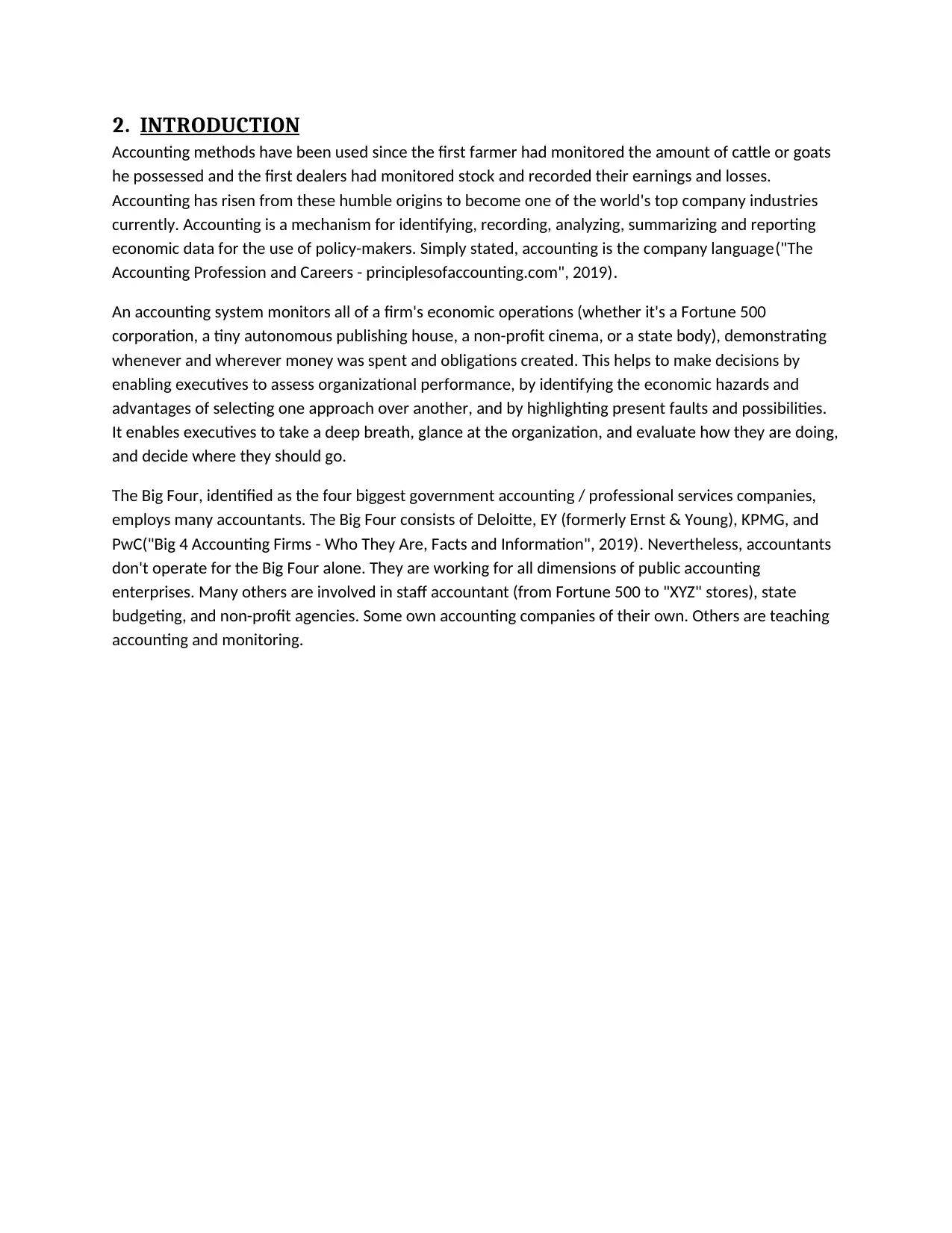
2. INTRODUCTION
Accounting methods have been used since the first farmer had monitored the amount of cattle or goats
he possessed and the first dealers had monitored stock and recorded their earnings and losses.
Accounting has risen from these humble origins to become one of the world's top company industries
currently. Accounting is a mechanism for identifying, recording, analyzing, summarizing and reporting
economic data for the use of policy-makers. Simply stated, accounting is the company language("The
Accounting Profession and Careers - principlesofaccounting.com", 2019).
An accounting system monitors all of a firm's economic operations (whether it's a Fortune 500
corporation, a tiny autonomous publishing house, a non-profit cinema, or a state body), demonstrating
whenever and wherever money was spent and obligations created. This helps to make decisions by
enabling executives to assess organizational performance, by identifying the economic hazards and
advantages of selecting one approach over another, and by highlighting present faults and possibilities.
It enables executives to take a deep breath, glance at the organization, and evaluate how they are doing,
and decide where they should go.
The Big Four, identified as the four biggest government accounting / professional services companies,
employs many accountants. The Big Four consists of Deloitte, EY (formerly Ernst & Young), KPMG, and
PwC("Big 4 Accounting Firms - Who They Are, Facts and Information", 2019). Nevertheless, accountants
don't operate for the Big Four alone. They are working for all dimensions of public accounting
enterprises. Many others are involved in staff accountant (from Fortune 500 to "XYZ" stores), state
budgeting, and non-profit agencies. Some own accounting companies of their own. Others are teaching
accounting and monitoring.
Accounting methods have been used since the first farmer had monitored the amount of cattle or goats
he possessed and the first dealers had monitored stock and recorded their earnings and losses.
Accounting has risen from these humble origins to become one of the world's top company industries
currently. Accounting is a mechanism for identifying, recording, analyzing, summarizing and reporting
economic data for the use of policy-makers. Simply stated, accounting is the company language("The
Accounting Profession and Careers - principlesofaccounting.com", 2019).
An accounting system monitors all of a firm's economic operations (whether it's a Fortune 500
corporation, a tiny autonomous publishing house, a non-profit cinema, or a state body), demonstrating
whenever and wherever money was spent and obligations created. This helps to make decisions by
enabling executives to assess organizational performance, by identifying the economic hazards and
advantages of selecting one approach over another, and by highlighting present faults and possibilities.
It enables executives to take a deep breath, glance at the organization, and evaluate how they are doing,
and decide where they should go.
The Big Four, identified as the four biggest government accounting / professional services companies,
employs many accountants. The Big Four consists of Deloitte, EY (formerly Ernst & Young), KPMG, and
PwC("Big 4 Accounting Firms - Who They Are, Facts and Information", 2019). Nevertheless, accountants
don't operate for the Big Four alone. They are working for all dimensions of public accounting
enterprises. Many others are involved in staff accountant (from Fortune 500 to "XYZ" stores), state
budgeting, and non-profit agencies. Some own accounting companies of their own. Others are teaching
accounting and monitoring.
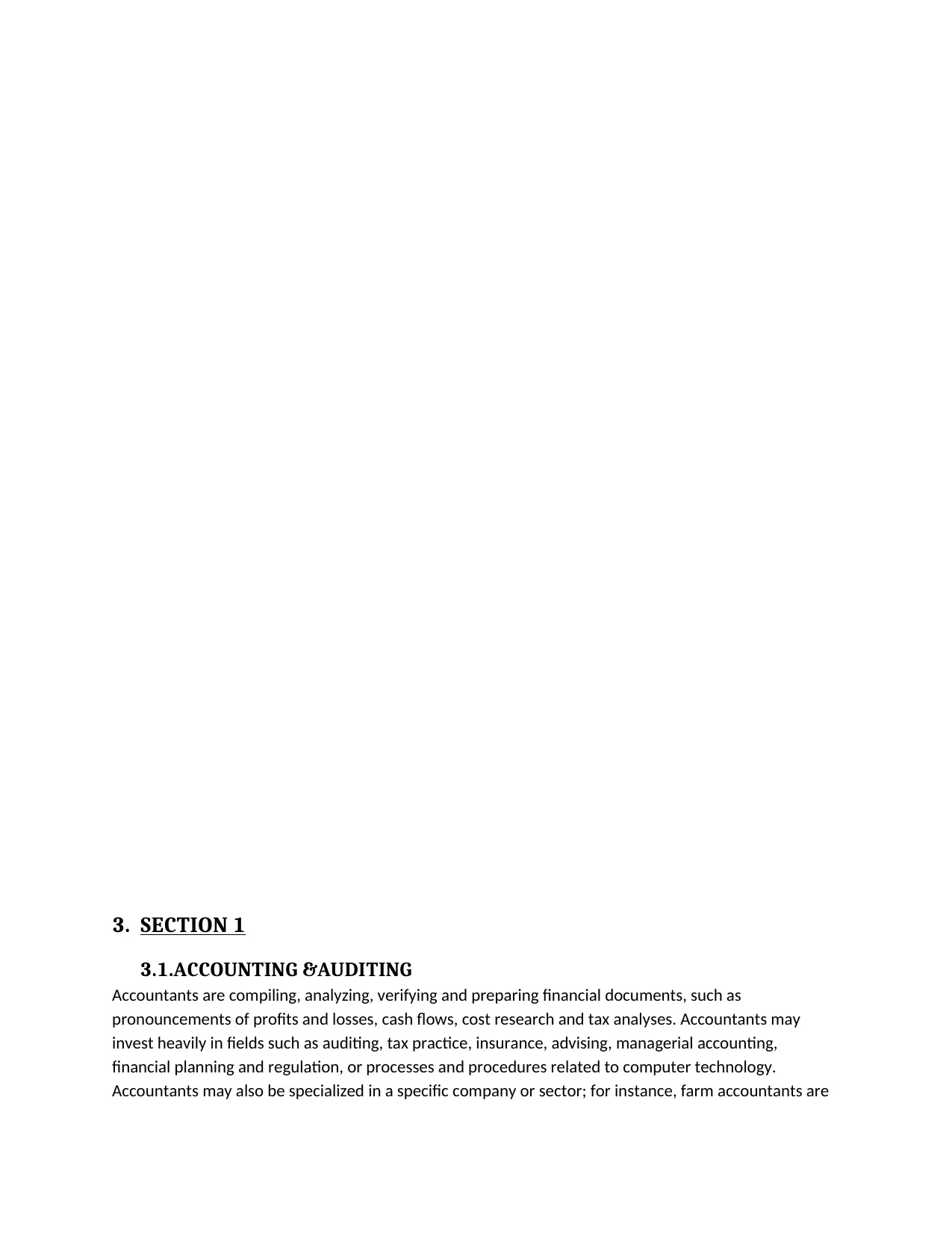
3. SECTION 1
3.1.ACCOUNTING &AUDITING
Accountants are compiling, analyzing, verifying and preparing financial documents, such as
pronouncements of profits and losses, cash flows, cost research and tax analyses. Accountants may
invest heavily in fields such as auditing, tax practice, insurance, advising, managerial accounting,
financial planning and regulation, or processes and procedures related to computer technology.
Accountants may also be specialized in a specific company or sector; for instance, farm accountants are
3.1.ACCOUNTING &AUDITING
Accountants are compiling, analyzing, verifying and preparing financial documents, such as
pronouncements of profits and losses, cash flows, cost research and tax analyses. Accountants may
invest heavily in fields such as auditing, tax practice, insurance, advising, managerial accounting,
financial planning and regulation, or processes and procedures related to computer technology.
Accountants may also be specialized in a specific company or sector; for instance, farm accountants are
⊘ This is a preview!⊘
Do you want full access?
Subscribe today to unlock all pages.

Trusted by 1+ million students worldwide
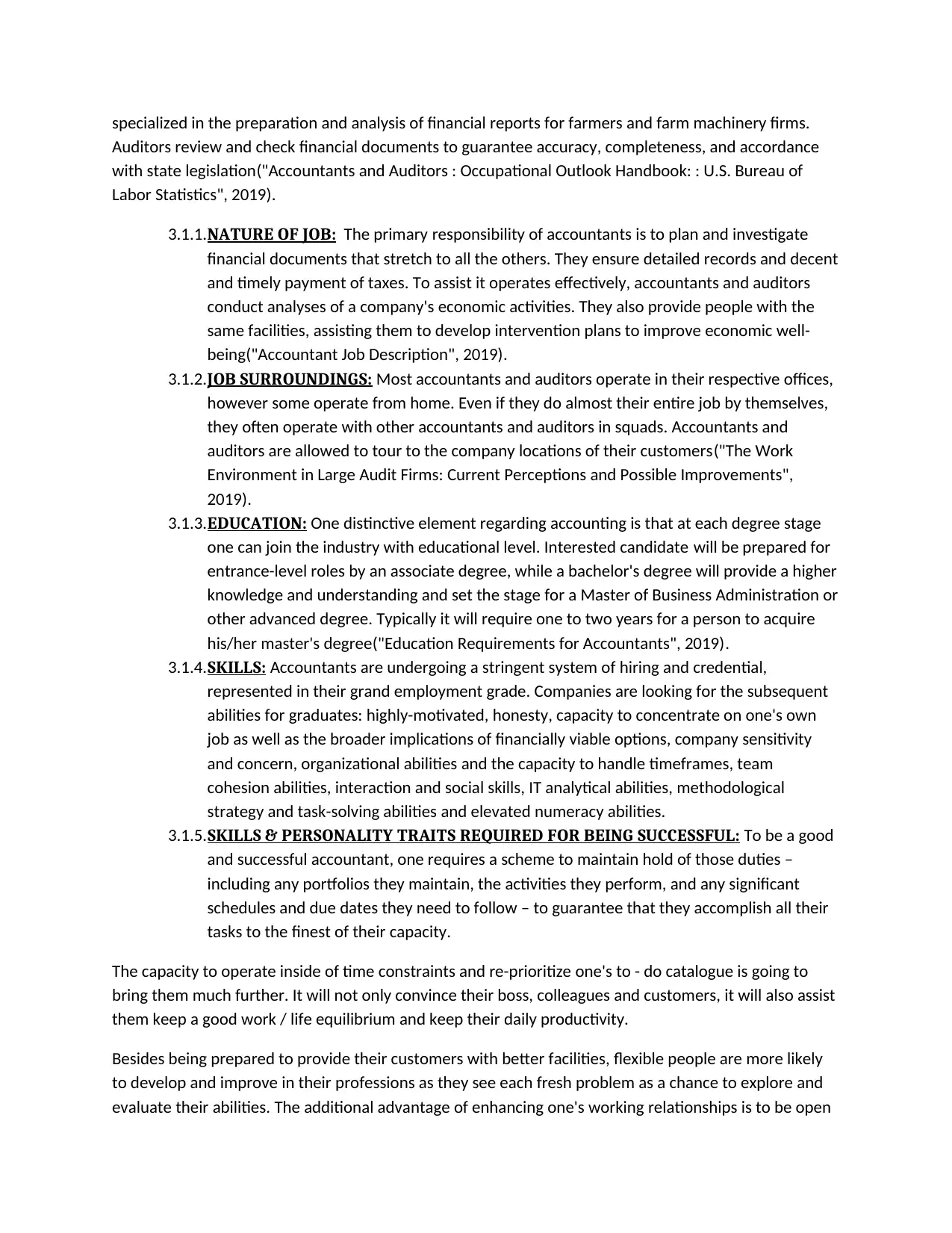
specialized in the preparation and analysis of financial reports for farmers and farm machinery firms.
Auditors review and check financial documents to guarantee accuracy, completeness, and accordance
with state legislation("Accountants and Auditors : Occupational Outlook Handbook: : U.S. Bureau of
Labor Statistics", 2019).
3.1.1.NATURE OF JOB: The primary responsibility of accountants is to plan and investigate
financial documents that stretch to all the others. They ensure detailed records and decent
and timely payment of taxes. To assist it operates effectively, accountants and auditors
conduct analyses of a company's economic activities. They also provide people with the
same facilities, assisting them to develop intervention plans to improve economic well-
being("Accountant Job Description", 2019).
3.1.2.JOB SURROUNDINGS: Most accountants and auditors operate in their respective offices,
however some operate from home. Even if they do almost their entire job by themselves,
they often operate with other accountants and auditors in squads. Accountants and
auditors are allowed to tour to the company locations of their customers("The Work
Environment in Large Audit Firms: Current Perceptions and Possible Improvements",
2019).
3.1.3.EDUCATION: One distinctive element regarding accounting is that at each degree stage
one can join the industry with educational level. Interested candidate will be prepared for
entrance-level roles by an associate degree, while a bachelor's degree will provide a higher
knowledge and understanding and set the stage for a Master of Business Administration or
other advanced degree. Typically it will require one to two years for a person to acquire
his/her master's degree("Education Requirements for Accountants", 2019).
3.1.4.SKILLS: Accountants are undergoing a stringent system of hiring and credential,
represented in their grand employment grade. Companies are looking for the subsequent
abilities for graduates: highly-motivated, honesty, capacity to concentrate on one's own
job as well as the broader implications of financially viable options, company sensitivity
and concern, organizational abilities and the capacity to handle timeframes, team
cohesion abilities, interaction and social skills, IT analytical abilities, methodological
strategy and task-solving abilities and elevated numeracy abilities.
3.1.5.SKILLS & PERSONALITY TRAITS REQUIRED FOR BEING SUCCESSFUL: To be a good
and successful accountant, one requires a scheme to maintain hold of those duties –
including any portfolios they maintain, the activities they perform, and any significant
schedules and due dates they need to follow – to guarantee that they accomplish all their
tasks to the finest of their capacity.
The capacity to operate inside of time constraints and re-prioritize one's to - do catalogue is going to
bring them much further. It will not only convince their boss, colleagues and customers, it will also assist
them keep a good work / life equilibrium and keep their daily productivity.
Besides being prepared to provide their customers with better facilities, flexible people are more likely
to develop and improve in their professions as they see each fresh problem as a chance to explore and
evaluate their abilities. The additional advantage of enhancing one's working relationships is to be open
Auditors review and check financial documents to guarantee accuracy, completeness, and accordance
with state legislation("Accountants and Auditors : Occupational Outlook Handbook: : U.S. Bureau of
Labor Statistics", 2019).
3.1.1.NATURE OF JOB: The primary responsibility of accountants is to plan and investigate
financial documents that stretch to all the others. They ensure detailed records and decent
and timely payment of taxes. To assist it operates effectively, accountants and auditors
conduct analyses of a company's economic activities. They also provide people with the
same facilities, assisting them to develop intervention plans to improve economic well-
being("Accountant Job Description", 2019).
3.1.2.JOB SURROUNDINGS: Most accountants and auditors operate in their respective offices,
however some operate from home. Even if they do almost their entire job by themselves,
they often operate with other accountants and auditors in squads. Accountants and
auditors are allowed to tour to the company locations of their customers("The Work
Environment in Large Audit Firms: Current Perceptions and Possible Improvements",
2019).
3.1.3.EDUCATION: One distinctive element regarding accounting is that at each degree stage
one can join the industry with educational level. Interested candidate will be prepared for
entrance-level roles by an associate degree, while a bachelor's degree will provide a higher
knowledge and understanding and set the stage for a Master of Business Administration or
other advanced degree. Typically it will require one to two years for a person to acquire
his/her master's degree("Education Requirements for Accountants", 2019).
3.1.4.SKILLS: Accountants are undergoing a stringent system of hiring and credential,
represented in their grand employment grade. Companies are looking for the subsequent
abilities for graduates: highly-motivated, honesty, capacity to concentrate on one's own
job as well as the broader implications of financially viable options, company sensitivity
and concern, organizational abilities and the capacity to handle timeframes, team
cohesion abilities, interaction and social skills, IT analytical abilities, methodological
strategy and task-solving abilities and elevated numeracy abilities.
3.1.5.SKILLS & PERSONALITY TRAITS REQUIRED FOR BEING SUCCESSFUL: To be a good
and successful accountant, one requires a scheme to maintain hold of those duties –
including any portfolios they maintain, the activities they perform, and any significant
schedules and due dates they need to follow – to guarantee that they accomplish all their
tasks to the finest of their capacity.
The capacity to operate inside of time constraints and re-prioritize one's to - do catalogue is going to
bring them much further. It will not only convince their boss, colleagues and customers, it will also assist
them keep a good work / life equilibrium and keep their daily productivity.
Besides being prepared to provide their customers with better facilities, flexible people are more likely
to develop and improve in their professions as they see each fresh problem as a chance to explore and
evaluate their abilities. The additional advantage of enhancing one's working relationships is to be open
Paraphrase This Document
Need a fresh take? Get an instant paraphrase of this document with our AI Paraphraser
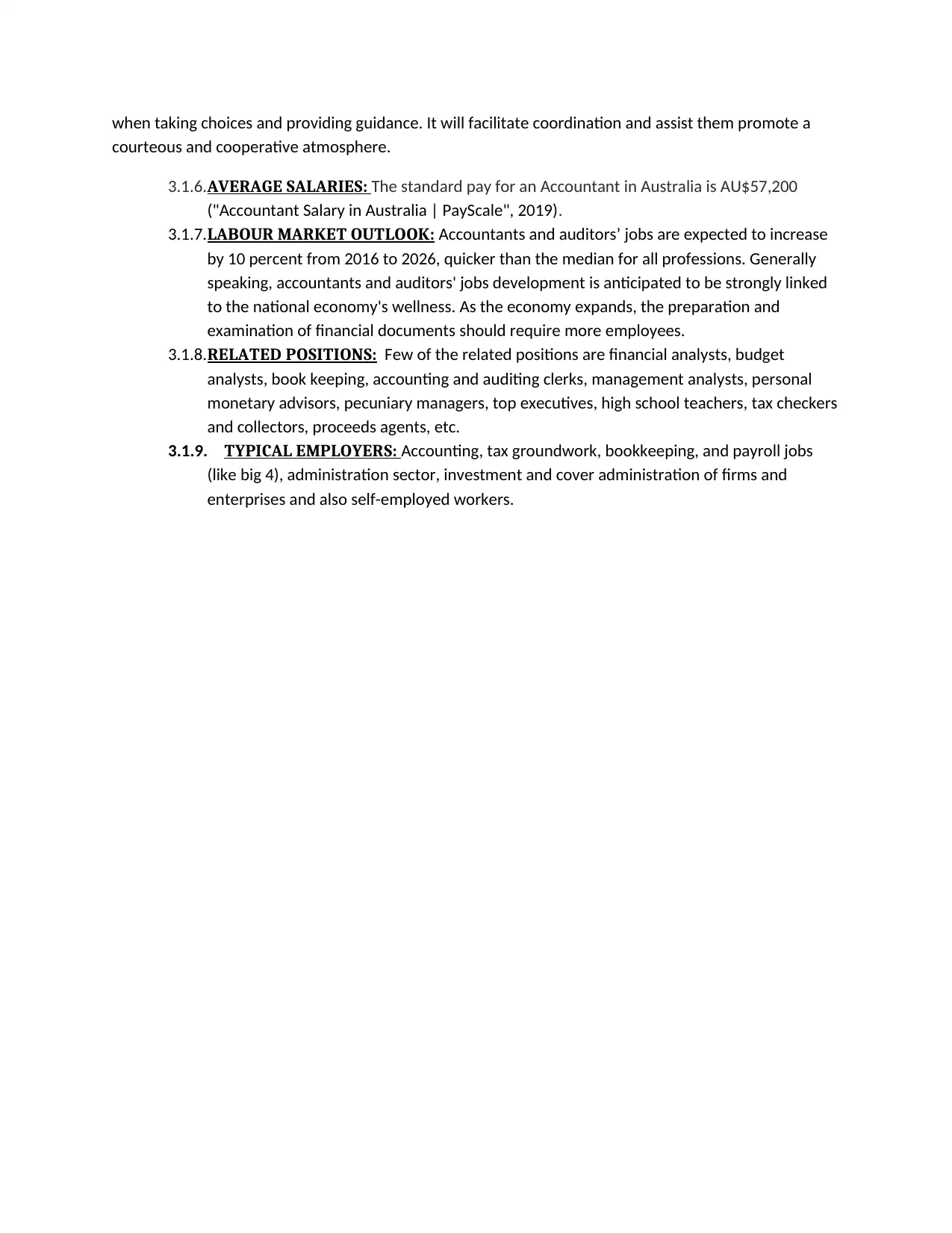
when taking choices and providing guidance. It will facilitate coordination and assist them promote a
courteous and cooperative atmosphere.
3.1.6.AVERAGE SALARIES: The standard pay for an Accountant in Australia is AU$57,200
("Accountant Salary in Australia | PayScale", 2019).
3.1.7.LABOUR MARKET OUTLOOK: Accountants and auditors’ jobs are expected to increase
by 10 percent from 2016 to 2026, quicker than the median for all professions. Generally
speaking, accountants and auditors' jobs development is anticipated to be strongly linked
to the national economy's wellness. As the economy expands, the preparation and
examination of financial documents should require more employees.
3.1.8.RELATED POSITIONS: Few of the related positions are financial analysts, budget
analysts, book keeping, accounting and auditing clerks, management analysts, personal
monetary advisors, pecuniary managers, top executives, high school teachers, tax checkers
and collectors, proceeds agents, etc.
3.1.9. TYPICAL EMPLOYERS: Accounting, tax groundwork, bookkeeping, and payroll jobs
(like big 4), administration sector, investment and cover administration of firms and
enterprises and also self-employed workers.
courteous and cooperative atmosphere.
3.1.6.AVERAGE SALARIES: The standard pay for an Accountant in Australia is AU$57,200
("Accountant Salary in Australia | PayScale", 2019).
3.1.7.LABOUR MARKET OUTLOOK: Accountants and auditors’ jobs are expected to increase
by 10 percent from 2016 to 2026, quicker than the median for all professions. Generally
speaking, accountants and auditors' jobs development is anticipated to be strongly linked
to the national economy's wellness. As the economy expands, the preparation and
examination of financial documents should require more employees.
3.1.8.RELATED POSITIONS: Few of the related positions are financial analysts, budget
analysts, book keeping, accounting and auditing clerks, management analysts, personal
monetary advisors, pecuniary managers, top executives, high school teachers, tax checkers
and collectors, proceeds agents, etc.
3.1.9. TYPICAL EMPLOYERS: Accounting, tax groundwork, bookkeeping, and payroll jobs
(like big 4), administration sector, investment and cover administration of firms and
enterprises and also self-employed workers.
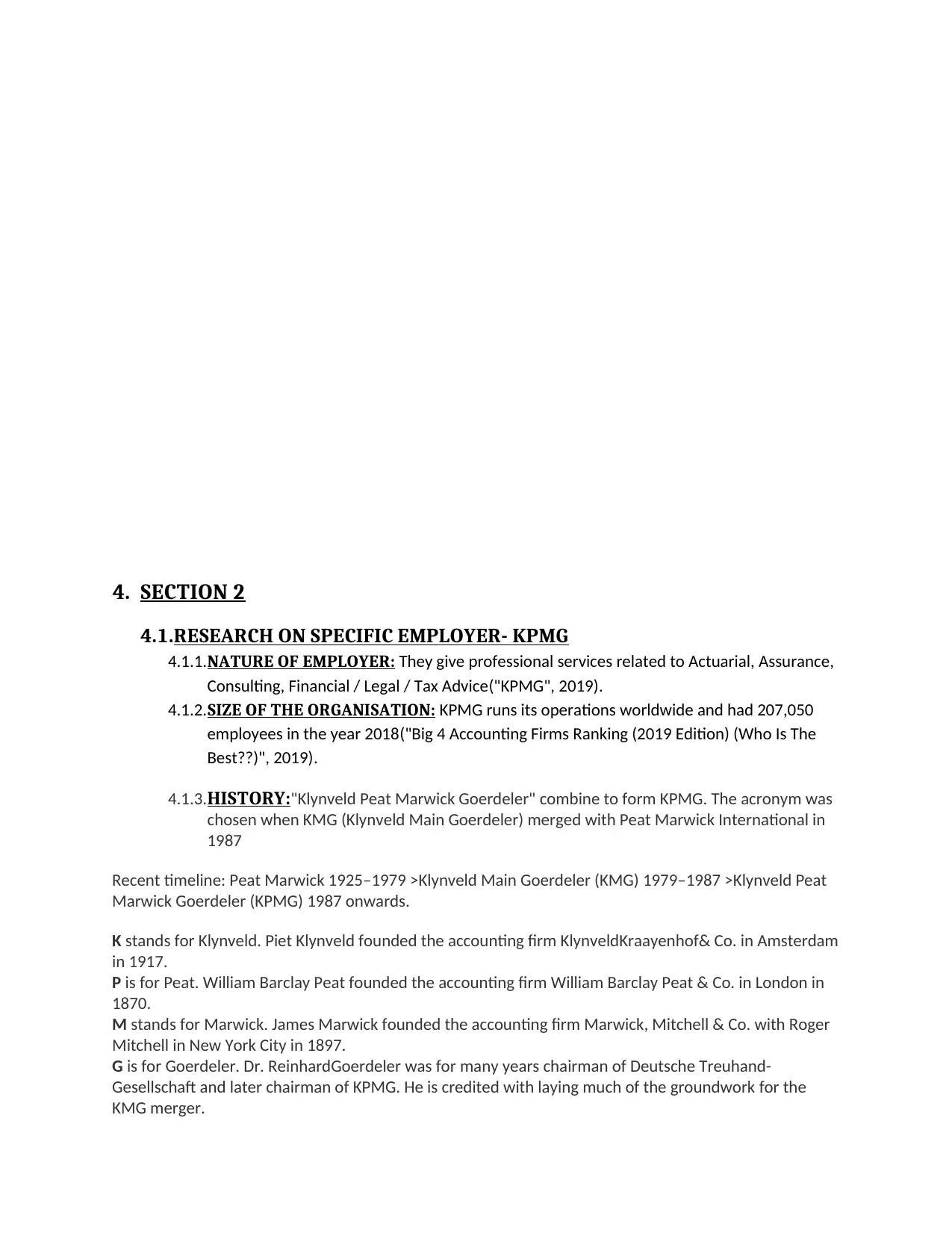
4. SECTION 2
4.1.RESEARCH ON SPECIFIC EMPLOYER- KPMG
4.1.1.NATURE OF EMPLOYER: They give professional services related to Actuarial, Assurance,
Consulting, Financial / Legal / Tax Advice("KPMG", 2019).
4.1.2.SIZE OF THE ORGANISATION: KPMG runs its operations worldwide and had 207,050
employees in the year 2018("Big 4 Accounting Firms Ranking (2019 Edition) (Who Is The
Best??)", 2019).
4.1.3.HISTORY:"Klynveld Peat Marwick Goerdeler" combine to form KPMG. The acronym was
chosen when KMG (Klynveld Main Goerdeler) merged with Peat Marwick International in
1987
Recent timeline: Peat Marwick 1925–1979 >Klynveld Main Goerdeler (KMG) 1979–1987 >Klynveld Peat
Marwick Goerdeler (KPMG) 1987 onwards.
K stands for Klynveld. Piet Klynveld founded the accounting firm KlynveldKraayenhof& Co. in Amsterdam
in 1917.
P is for Peat. William Barclay Peat founded the accounting firm William Barclay Peat & Co. in London in
1870.
M stands for Marwick. James Marwick founded the accounting firm Marwick, Mitchell & Co. with Roger
Mitchell in New York City in 1897.
G is for Goerdeler. Dr. ReinhardGoerdeler was for many years chairman of Deutsche Treuhand-
Gesellschaft and later chairman of KPMG. He is credited with laying much of the groundwork for the
KMG merger.
4.1.RESEARCH ON SPECIFIC EMPLOYER- KPMG
4.1.1.NATURE OF EMPLOYER: They give professional services related to Actuarial, Assurance,
Consulting, Financial / Legal / Tax Advice("KPMG", 2019).
4.1.2.SIZE OF THE ORGANISATION: KPMG runs its operations worldwide and had 207,050
employees in the year 2018("Big 4 Accounting Firms Ranking (2019 Edition) (Who Is The
Best??)", 2019).
4.1.3.HISTORY:"Klynveld Peat Marwick Goerdeler" combine to form KPMG. The acronym was
chosen when KMG (Klynveld Main Goerdeler) merged with Peat Marwick International in
1987
Recent timeline: Peat Marwick 1925–1979 >Klynveld Main Goerdeler (KMG) 1979–1987 >Klynveld Peat
Marwick Goerdeler (KPMG) 1987 onwards.
K stands for Klynveld. Piet Klynveld founded the accounting firm KlynveldKraayenhof& Co. in Amsterdam
in 1917.
P is for Peat. William Barclay Peat founded the accounting firm William Barclay Peat & Co. in London in
1870.
M stands for Marwick. James Marwick founded the accounting firm Marwick, Mitchell & Co. with Roger
Mitchell in New York City in 1897.
G is for Goerdeler. Dr. ReinhardGoerdeler was for many years chairman of Deutsche Treuhand-
Gesellschaft and later chairman of KPMG. He is credited with laying much of the groundwork for the
KMG merger.
⊘ This is a preview!⊘
Do you want full access?
Subscribe today to unlock all pages.

Trusted by 1+ million students worldwide
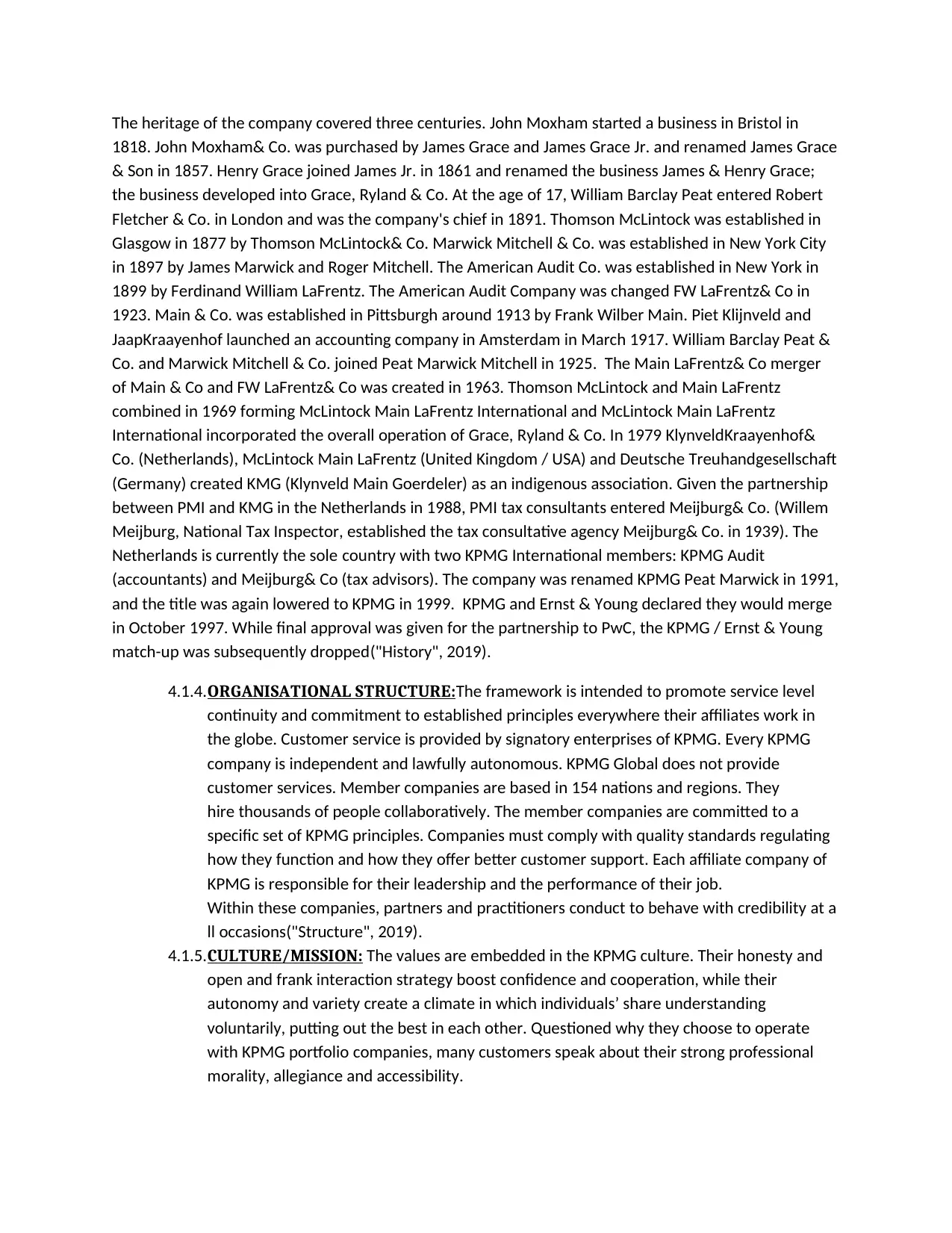
The heritage of the company covered three centuries. John Moxham started a business in Bristol in
1818. John Moxham& Co. was purchased by James Grace and James Grace Jr. and renamed James Grace
& Son in 1857. Henry Grace joined James Jr. in 1861 and renamed the business James & Henry Grace;
the business developed into Grace, Ryland & Co. At the age of 17, William Barclay Peat entered Robert
Fletcher & Co. in London and was the company's chief in 1891. Thomson McLintock was established in
Glasgow in 1877 by Thomson McLintock& Co. Marwick Mitchell & Co. was established in New York City
in 1897 by James Marwick and Roger Mitchell. The American Audit Co. was established in New York in
1899 by Ferdinand William LaFrentz. The American Audit Company was changed FW LaFrentz& Co in
1923. Main & Co. was established in Pittsburgh around 1913 by Frank Wilber Main. Piet Klijnveld and
JaapKraayenhof launched an accounting company in Amsterdam in March 1917. William Barclay Peat &
Co. and Marwick Mitchell & Co. joined Peat Marwick Mitchell in 1925. The Main LaFrentz& Co merger
of Main & Co and FW LaFrentz& Co was created in 1963. Thomson McLintock and Main LaFrentz
combined in 1969 forming McLintock Main LaFrentz International and McLintock Main LaFrentz
International incorporated the overall operation of Grace, Ryland & Co. In 1979 KlynveldKraayenhof&
Co. (Netherlands), McLintock Main LaFrentz (United Kingdom / USA) and Deutsche Treuhandgesellschaft
(Germany) created KMG (Klynveld Main Goerdeler) as an indigenous association. Given the partnership
between PMI and KMG in the Netherlands in 1988, PMI tax consultants entered Meijburg& Co. (Willem
Meijburg, National Tax Inspector, established the tax consultative agency Meijburg& Co. in 1939). The
Netherlands is currently the sole country with two KPMG International members: KPMG Audit
(accountants) and Meijburg& Co (tax advisors). The company was renamed KPMG Peat Marwick in 1991,
and the title was again lowered to KPMG in 1999. KPMG and Ernst & Young declared they would merge
in October 1997. While final approval was given for the partnership to PwC, the KPMG / Ernst & Young
match-up was subsequently dropped("History", 2019).
4.1.4.ORGANISATIONAL STRUCTURE:The framework is intended to promote service level
continuity and commitment to established principles everywhere their affiliates work in
the globe. Customer service is provided by signatory enterprises of KPMG. Every KPMG
company is independent and lawfully autonomous. KPMG Global does not provide
customer services. Member companies are based in 154 nations and regions. They
hire thousands of people collaboratively. The member companies are committed to a
specific set of KPMG principles. Companies must comply with quality standards regulating
how they function and how they offer better customer support. Each affiliate company of
KPMG is responsible for their leadership and the performance of their job.
Within these companies, partners and practitioners conduct to behave with credibility at a
ll occasions("Structure", 2019).
4.1.5.CULTURE/MISSION: The values are embedded in the KPMG culture. Their honesty and
open and frank interaction strategy boost confidence and cooperation, while their
autonomy and variety create a climate in which individuals’ share understanding
voluntarily, putting out the best in each other. Questioned why they choose to operate
with KPMG portfolio companies, many customers speak about their strong professional
morality, allegiance and accessibility.
1818. John Moxham& Co. was purchased by James Grace and James Grace Jr. and renamed James Grace
& Son in 1857. Henry Grace joined James Jr. in 1861 and renamed the business James & Henry Grace;
the business developed into Grace, Ryland & Co. At the age of 17, William Barclay Peat entered Robert
Fletcher & Co. in London and was the company's chief in 1891. Thomson McLintock was established in
Glasgow in 1877 by Thomson McLintock& Co. Marwick Mitchell & Co. was established in New York City
in 1897 by James Marwick and Roger Mitchell. The American Audit Co. was established in New York in
1899 by Ferdinand William LaFrentz. The American Audit Company was changed FW LaFrentz& Co in
1923. Main & Co. was established in Pittsburgh around 1913 by Frank Wilber Main. Piet Klijnveld and
JaapKraayenhof launched an accounting company in Amsterdam in March 1917. William Barclay Peat &
Co. and Marwick Mitchell & Co. joined Peat Marwick Mitchell in 1925. The Main LaFrentz& Co merger
of Main & Co and FW LaFrentz& Co was created in 1963. Thomson McLintock and Main LaFrentz
combined in 1969 forming McLintock Main LaFrentz International and McLintock Main LaFrentz
International incorporated the overall operation of Grace, Ryland & Co. In 1979 KlynveldKraayenhof&
Co. (Netherlands), McLintock Main LaFrentz (United Kingdom / USA) and Deutsche Treuhandgesellschaft
(Germany) created KMG (Klynveld Main Goerdeler) as an indigenous association. Given the partnership
between PMI and KMG in the Netherlands in 1988, PMI tax consultants entered Meijburg& Co. (Willem
Meijburg, National Tax Inspector, established the tax consultative agency Meijburg& Co. in 1939). The
Netherlands is currently the sole country with two KPMG International members: KPMG Audit
(accountants) and Meijburg& Co (tax advisors). The company was renamed KPMG Peat Marwick in 1991,
and the title was again lowered to KPMG in 1999. KPMG and Ernst & Young declared they would merge
in October 1997. While final approval was given for the partnership to PwC, the KPMG / Ernst & Young
match-up was subsequently dropped("History", 2019).
4.1.4.ORGANISATIONAL STRUCTURE:The framework is intended to promote service level
continuity and commitment to established principles everywhere their affiliates work in
the globe. Customer service is provided by signatory enterprises of KPMG. Every KPMG
company is independent and lawfully autonomous. KPMG Global does not provide
customer services. Member companies are based in 154 nations and regions. They
hire thousands of people collaboratively. The member companies are committed to a
specific set of KPMG principles. Companies must comply with quality standards regulating
how they function and how they offer better customer support. Each affiliate company of
KPMG is responsible for their leadership and the performance of their job.
Within these companies, partners and practitioners conduct to behave with credibility at a
ll occasions("Structure", 2019).
4.1.5.CULTURE/MISSION: The values are embedded in the KPMG culture. Their honesty and
open and frank interaction strategy boost confidence and cooperation, while their
autonomy and variety create a climate in which individuals’ share understanding
voluntarily, putting out the best in each other. Questioned why they choose to operate
with KPMG portfolio companies, many customers speak about their strong professional
morality, allegiance and accessibility.
Paraphrase This Document
Need a fresh take? Get an instant paraphrase of this document with our AI Paraphraser
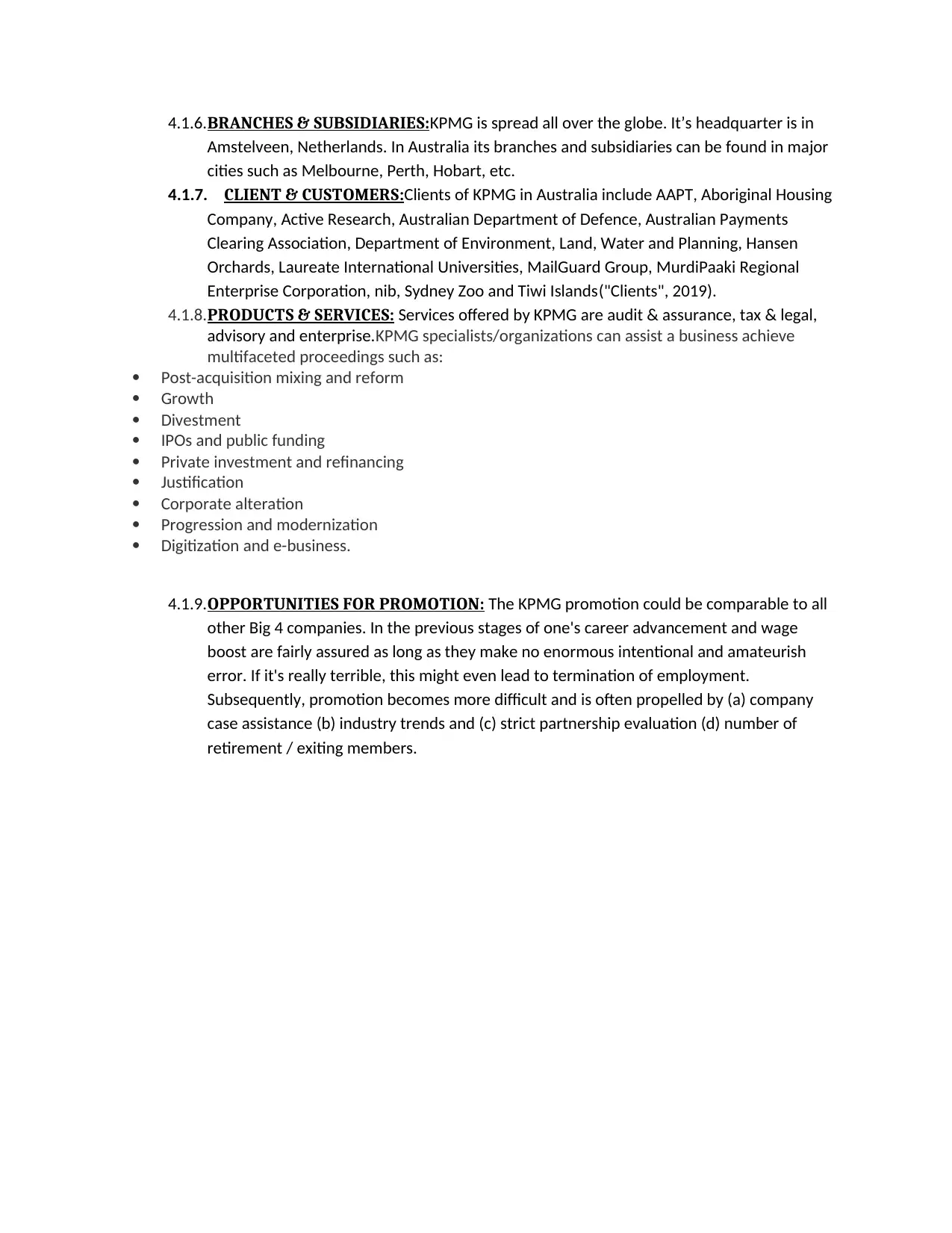
4.1.6.BRANCHES & SUBSIDIARIES:KPMG is spread all over the globe. It’s headquarter is in
Amstelveen, Netherlands. In Australia its branches and subsidiaries can be found in major
cities such as Melbourne, Perth, Hobart, etc.
4.1.7. CLIENT & CUSTOMERS:Clients of KPMG in Australia include AAPT, Aboriginal Housing
Company, Active Research, Australian Department of Defence, Australian Payments
Clearing Association, Department of Environment, Land, Water and Planning, Hansen
Orchards, Laureate International Universities, MailGuard Group, MurdiPaaki Regional
Enterprise Corporation, nib, Sydney Zoo and Tiwi Islands("Clients", 2019).
4.1.8.PRODUCTS & SERVICES: Services offered by KPMG are audit & assurance, tax & legal,
advisory and enterprise.KPMG specialists/organizations can assist a business achieve
multifaceted proceedings such as:
Post-acquisition mixing and reform
Growth
Divestment
IPOs and public funding
Private investment and refinancing
Justification
Corporate alteration
Progression and modernization
Digitization and e-business.
4.1.9.OPPORTUNITIES FOR PROMOTION: The KPMG promotion could be comparable to all
other Big 4 companies. In the previous stages of one's career advancement and wage
boost are fairly assured as long as they make no enormous intentional and amateurish
error. If it's really terrible, this might even lead to termination of employment.
Subsequently, promotion becomes more difficult and is often propelled by (a) company
case assistance (b) industry trends and (c) strict partnership evaluation (d) number of
retirement / exiting members.
Amstelveen, Netherlands. In Australia its branches and subsidiaries can be found in major
cities such as Melbourne, Perth, Hobart, etc.
4.1.7. CLIENT & CUSTOMERS:Clients of KPMG in Australia include AAPT, Aboriginal Housing
Company, Active Research, Australian Department of Defence, Australian Payments
Clearing Association, Department of Environment, Land, Water and Planning, Hansen
Orchards, Laureate International Universities, MailGuard Group, MurdiPaaki Regional
Enterprise Corporation, nib, Sydney Zoo and Tiwi Islands("Clients", 2019).
4.1.8.PRODUCTS & SERVICES: Services offered by KPMG are audit & assurance, tax & legal,
advisory and enterprise.KPMG specialists/organizations can assist a business achieve
multifaceted proceedings such as:
Post-acquisition mixing and reform
Growth
Divestment
IPOs and public funding
Private investment and refinancing
Justification
Corporate alteration
Progression and modernization
Digitization and e-business.
4.1.9.OPPORTUNITIES FOR PROMOTION: The KPMG promotion could be comparable to all
other Big 4 companies. In the previous stages of one's career advancement and wage
boost are fairly assured as long as they make no enormous intentional and amateurish
error. If it's really terrible, this might even lead to termination of employment.
Subsequently, promotion becomes more difficult and is often propelled by (a) company
case assistance (b) industry trends and (c) strict partnership evaluation (d) number of
retirement / exiting members.
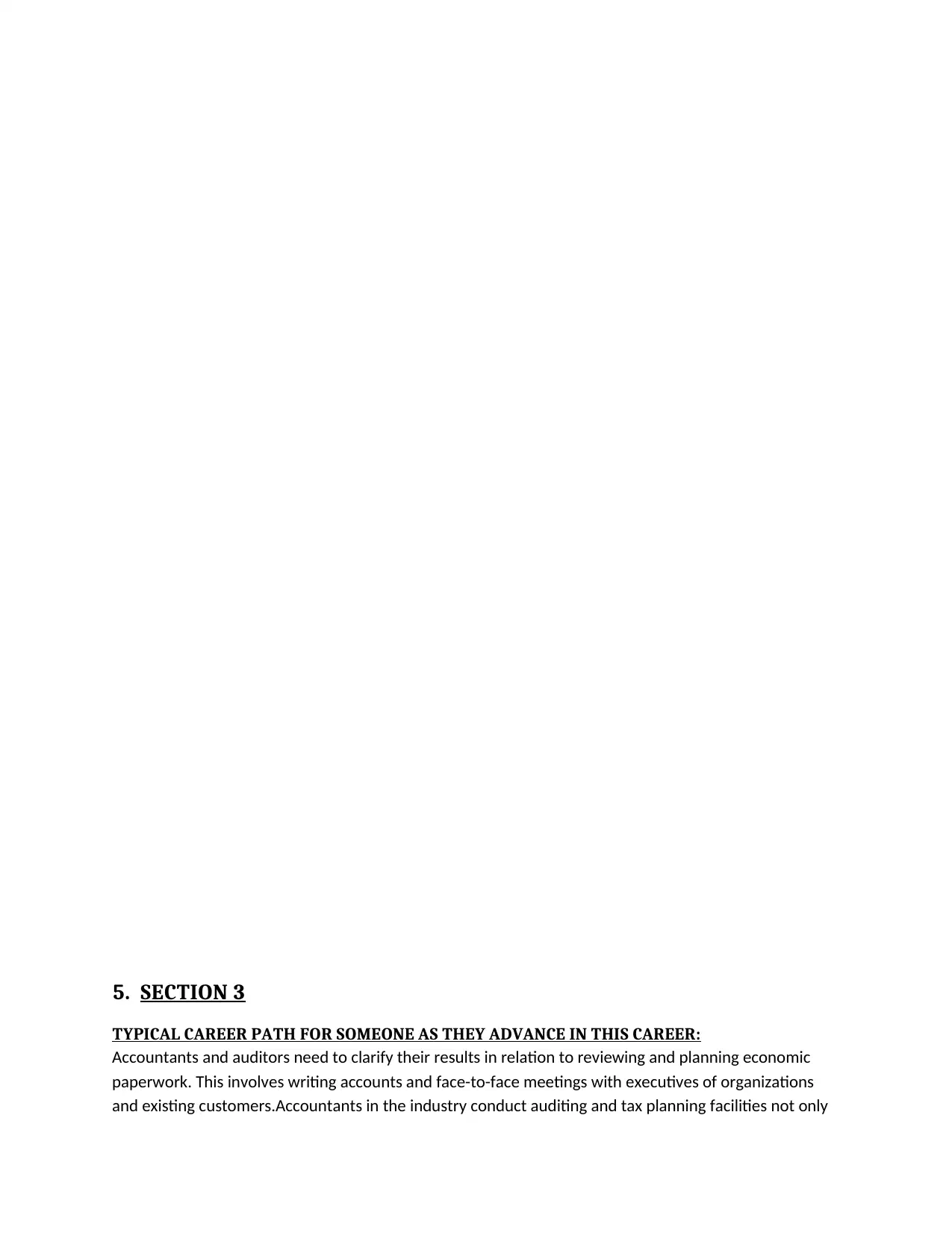
5. SECTION 3
TYPICAL CAREER PATH FOR SOMEONE AS THEY ADVANCE IN THIS CAREER:
Accountants and auditors need to clarify their results in relation to reviewing and planning economic
paperwork. This involves writing accounts and face-to-face meetings with executives of organizations
and existing customers.Accountants in the industry conduct auditing and tax planning facilities not only
TYPICAL CAREER PATH FOR SOMEONE AS THEY ADVANCE IN THIS CAREER:
Accountants and auditors need to clarify their results in relation to reviewing and planning economic
paperwork. This involves writing accounts and face-to-face meetings with executives of organizations
and existing customers.Accountants in the industry conduct auditing and tax planning facilities not only
⊘ This is a preview!⊘
Do you want full access?
Subscribe today to unlock all pages.

Trusted by 1+ million students worldwide
1 out of 17
Related Documents
Your All-in-One AI-Powered Toolkit for Academic Success.
+13062052269
info@desklib.com
Available 24*7 on WhatsApp / Email
![[object Object]](/_next/static/media/star-bottom.7253800d.svg)
Unlock your academic potential
Copyright © 2020–2025 A2Z Services. All Rights Reserved. Developed and managed by ZUCOL.





